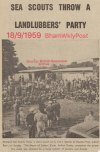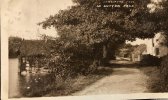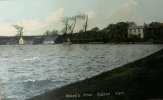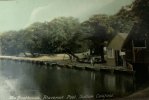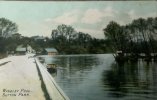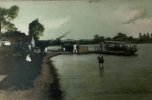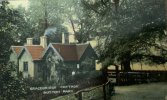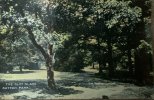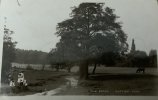-
Welcome to this forum . We are a worldwide group with a common interest in Birmingham and its history. While here, please follow a few simple rules. We ask that you respect other members, thank those who have helped you and please keep your contributions on-topic with the thread.
We do hope you enjoy your visit. BHF Admin Team
You are using an out of date browser. It may not display this or other websites correctly.
You should upgrade or use an alternative browser.
You should upgrade or use an alternative browser.
Richard Dye
master brummie
Did not place a bet this year............Now I have a few extra $ to waste elsewhereI usually place one bet per year (maybe) at the Kentucky Derby (was spared this year). My record has nothing to do with winning, just to not be last!Just like to support the bookies

Anyone know anything about Crystal Palace that was in Sutton Park on the site were the Old Fair Ground
was in the 50's -60's
Crystal Palace and the Fair. Welcome to the Pleasure Dome. Roughly where the Leisure Centre stands today over a 150 years ago there was a magnificent entertainment called The Royal Promenade Gardens. It covered 10 acres and had a fernery, large rhododendron area, Rose beds, an Italian garden, lawns, ornamental plantations, a bowling green, cricket, archery and croquet areas. It also has an ornamental lake and a conservatory. The conservatory was modelled on the Crystal Palace built for the Great Exhibition of1851 and called after it. There was a hotel next to it with shelter for 1500 people and stabling for 50 horses, 30 acres of meadow. Facilities for boating fishing, cycling and children’s swings completed the offerings. It was also noted there were shady avenues and arbours for “spooning”. All of this was the creation of a market gardener called Job Cole who converted his land there to create it. He was an experienced horticulturist and business man having previously owned market gardens in the Birmingham Area. It is unclear how he would finance such a massive undertaking but it was one of the results of the expansion of the railways coupled with very cheap fares. Sutton was to be blessed with three stations, two lines and a third planned. Speculation in all fields followed the railway and various conspicuous figures in the Sutton area saw profits to be made so he would have had access to such monies. Sutton was already very well regarded for its air and pleasant climate. Excursions from Birmingham were popular and frequent. The coming of the railway was to raise this to a completely different level 110,000 visitors came each year with railway excursion ticket sales of 77500. Everybody seemed to be making money and Sutton saw a housing and development boom. Cole went public but initial euphoria died and the site did not turn out to be profitable in the long term. It must be speculation without access to the books but it seems likely that with an Rail Excursion costing only a Shilling including admittance to the Gardens was a bargain for the visitor and the Railway Company but not to Mr Cole. The entry price to visitors arriving in other ways was also one Shilling. Profit therefore relied on sales inside. Cole died in 1893 leaving £20.5s. A Mr Earle became the owner but as a businessman he was a good drunk, spending most of his timeCrystal Palace and the Fair. Welcome to the Pleasure Dome. Roughly where the Leisure Centre stands today over a 150 years ago there was a magnificent entertainment called The Royal Promenade Gardens. It covered 10 acres and had a fernery, large rhododendron area, Rose beds, an Italian garden, lawns, ornamental plantations, a bowling green, cricket, archery and croquet areas. It also has an ornamental lake and a conservatory. The conservatory was modelled on the Crystal Palace built for the Great Exhibition of1851 and called after it. There was a hotel next to it with shelter for 1500 people and stabling for 50 horses, 30 acres of meadow. Facilities for boating fishing, cycling and children’s swings completed the offerings. It was also noted there were shady avenues and arbours for “spooning”. All of this was the creation of a market gardener called Job Cole who converted his land there to create it. He was an experienced horticulturist and business man having previously owned market gardens in the Birmingham Area. It is unclear how he would finance such a massive undertaking but it was one of the results of the expansion of the railways coupled with very cheap fares. Sutton was to be blessed with three stations, two lines and a third planned. Speculation in all fields followed the railway and various conspicuous figures in the Sutton area saw profits to be made so he would have had access to such monies. Sutton was already very well regarded for its air and pleasant climate. Excursions from Birmingham were popular and frequent. The coming of the railway was to raise this to a completely different level 110,000 visitors came each year with railway excursion ticket sales of 77500. Everybody seemed to be making money and Sutton saw a housing and development boom. Cole went public but initial euphoria died and the site did not turn out to be profitable in the long term. It must be speculation without access to the books but it seems likely that with an Rail Excursion costing only a Shilling including admittance to the Gardens was a bargain for the visitor and the Railway Company but not to Mr Cole. The entry price to visitors arriving in other ways was also one Shilling. Profit therefore relied on sales inside. Cole died in 1893 leaving £20.5s. A Mr Earle became the owner but as a businessman he was a good drunk, spending most of his time in The .Museum.
Last edited:
He was in court for non payment of rates but when he got so drunk he fired a shotgun towards the hotel guests and a police officer business seemed inextricably to decline. There was also the minor matter of a floor collapse which pitched dancers into the cellar. A cabal of “The Captain”, “The Colonel” and “the Major” financed then took it on and organised an Oriental Art and Industrial Exhibition. The crowds stayed away in their thousands and it was a financial disaster. People had loaned items for display some of which were eventually returned but others were sold at auction which judging from the prices realised was fixed from start to finish. As none of these owners in fact owned the land they were estopped from actually selling non movables which enabled the buildings to survive the various financial misfortunes and brave souls to again hazard their money Eventually more finance was found and the 15”gauge railway was laid down in 1907 linking the Palace site with Wyndley pool for boating etc. Along came Pat Collins a showman and owner of 3 other fairgrounds in 1910. He introduced new large rides, ballroom dancing in the Palace, better catering and his concept of noise lights and movement. As an aside Pat Collins gave the Peaky Blinders such a beating they never tried again to muscle in on the world of funfairs
JackiePritchatt
master brummie
Super image. That must be Longmore Mill on the right with the boat house on the left.
Pedrocut
Master Barmmie
Longmore Pool, Sutton Park, 19th century. Creator: W. Green. # 2799776 - Heritage Images
View preview image #2799776 - Longmore Pool, Sutton Park, 19th century. Topographical view of Sutton Park, Sutton Coldfield, in the greater Birmingham area, showing Longmoor Pool with boathouse.
www.heritage-images.com
JackiePritchatt
master brummie
JackiePritchatt
master brummie
JackiePritchatt
master brummie
JackiePritchatt
master brummie
JackiePritchatt
master brummie
JackiePritchatt
master brummie
JackiePritchatt
master brummie
Richard Dye
master brummie
I so remember tha5 pool, the slide and swimming out to the raft! Thanks for sharing oldMohawk!Another photo of the Lido by Keepers Pool
View attachment 167419
Lady Penelope
master brummie
Amazing how many girls are wearing swimming caps oM. I remember mine so well. It didn't keep my hair dry, merely pulled my face uncomfortably to the sides and then squeaked and pulled my hair (which was very long) when I took it off leaving me with an all pervading smell of rubber. Not a success as far as I was concerned!
Happy memories of the lido though - my father went in his youth, I went as a teenager, and I took my children and grandchildren too.
Happy memories of the lido though - my father went in his youth, I went as a teenager, and I took my children and grandchildren too.
Bob Davis
Bob Davis
The swimming pool foBishop Veseyß, still shiver just looking at it.Another photo of the Lido by Keepers Pool
View attachment 167419
bobr
Birmingham Council is considering releasing the upkeep of the park to a Trust which it says will generate income for the upkeep of the park parts of which are in a state of disrepair especially the roads.
Always think of it as a bit of countryside near to home.
Always think of it as a bit of countryside near to home.
Richard Dye
master brummie
Lady P, you know I never understood those hats! My older sister had to take me everywhere including the lido and Grove Lane baths and wore one of those hats!Amazing how many girls are wearing swimming caps oM. I remember mine so well. It didn't keep my hair dry, merely pulled my face uncomfortably to the sides and then squeaked and pulled my hair (which was very long) when I took it off leaving me with an all pervading smell of rubber. Not a success as far as I was concerned!
Happy memories of the lido though - my father went in his youth, I went as a teenager, and I took my children and grandchildren too.
paul stacey
master brummie
Lovely photo, but thinking back to the 50's and 60's when the park was always busy, and humming, there was a massof wildlife, it looks practically deserted
oldMohawk
gone but not forgotten
The park was actually quite busy this morning but we all go in our cars and damage the place as a pic from my dashcam shows. I don't go there often these days but would happily pay to go in. Perhaps they need ANPR cameras on all the gates and we would have to pay remotely.Lovely photo, but thinking back to the 50's and 60's when the park was always busy, and humming, there was a massof wildlife, it looks practically deserted

Richard Dye
master brummie
Paul, what is the reason for fewer visitors, is it the payment?Lovely photo, but thinking back to the 50's and 60's when the park was always busy, and humming, there was a massof wildlife, it looks practically deserted
paul stacey
master brummie
The car park reminds me of the Tour of Aden, and the Radfan, on one of the better roads, see what you mean though.






